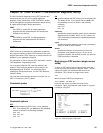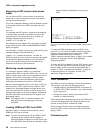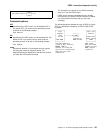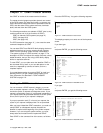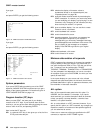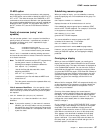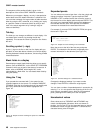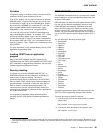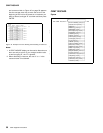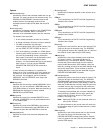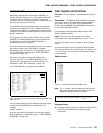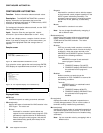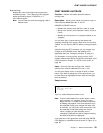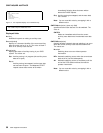
CEMT DISCARD
Variables
PF5 gives a display of variables, similar to that for the CECI
command. Here are some examples of its use.
From a FILE display, you may wish to inquire of a particular
DSNAME, which is typically 26 characters and can be up to
44 characters in length. Go to the expanded panel, position
the cursor on the DSNAME line, and press PF5. You now
have a variable &DSN with the required value. Type I
DSN(&DSN) on the command line, and press ENTER.
You may wish to find all the TSQUEUE names beginning
with a nondisplayable character—for example, X'FF'. Press
PF5 for the variables display. Enter X and 2 to make a
variable &X of length 2. Press PF2 to switch to hexadecimal,
and overtype ‘4040’ with ‘FF5C’ (‘%c’ is hexadecimal for the
asterisk (*) symbol). Type I TS(&X) on the command line and
press ENTER.
For more information on the variables display, see the
CICS
Application Programming Guide
.
Invoking CEMT from an application
program
Many of the CEMT INQUIRE and SET operations are
available through the EXEC CICS INQUIRE and EXEC CICS
SET commands; for programming information, see the
CICS
System Programming Reference
manual.
1
Security checking
The scope of a particular DISCARD, INQUIRE, SET, or
PERFORM command can be limited by a combination of
several levels of security checking. The normal
transaction-attach security is described in the
CICS RACF
Security Guide
. CEMT calls the exec interface programs to
process the user’s commands, in much the same way as
CECI or a user’s command-level program would. The
resource security and the command security used by the
command-level programming interface are thus applicable to
the master terminal user.
For programming information about command security
checking, see the
CICS System Programming Reference
manual.
CEMT DISCARD commands
The DISCARD command allows you to remove an installed
resource definition and its corresponding catalog entry from
an active CICS system.
DISCARD does not affect the CICS system definition (CSD)
file, and you can therefore reinstate the resource using
CEDA INSTALL(resourcename). DISCARD commands
require ALTER access to the resource to provide similar
security to that for SET commands (which use UPDATE
access). You cannot discard resources that are currently in
use or are CICS owned resources (beginning with “DFH” or
“C”).
You can discard the following resource types:
Autinstmodel
Connection
DB2Conn
DB2Entry
DB2Tran
| Doctemplate
| Enqmodel
FEPI node
FEPI pool
FEPI property set
FEPI target
File
JModel
Journalname
Partner
| Processtype
Profile
Program
| Requestmodel
TClass
| TCPIPservice
TDqueue
Terminal
Transaction.
| TSmodel
(Programming information about FEPI commands is in the
CICS Front End Programming Interface User's Guide
.)
There are two ways to discard a resource:
1. If you know the name of the resource that you want to
discard, type:
CEMT DISCARD resourcetype(resourcename)
2. If you do not know the name of the resource, type:
CEMT INQUIRE resourcetype
1
Users of earlier releases of CICS may be familiar with the old programmable interface to the master terminal program (DFHEMTA). Its use
is still supported, though the documentation is available only in the CICS libraries for releases prior to CICS Transaction Server for OS/390
Release 3.
Chapter 11. Master terminal CEMT
49



